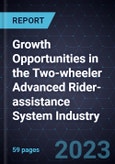Concerns Over the Rising Two-wheeler Related Accidents and the Focus on Improving Rider Assistance by OEMs and Governments will Drive the Adoption of ARAS in Two-wheelers
Global two-wheeler markets are transitioning from internal combustion engine (ICE) two-wheelers to electric two-wheelers. In that context, the design and development of software-defined platforms are crucial for OEMs. Furthermore, consumers are becoming deeply knowledgeable about vehicle specifications thanks to the influence of online social media and have started to demand advanced safety systems.
The entry of new players and new product launches has crowded the segment. Two-wheeler ARAS modules are currently expensive for cost-sensitive markets, so they’re not an option for the larger commuter segment riders. Aftermarket ARAS modules are susceptible to tampering, theft, and damage due to exposed fitting.
There has been an increasing number of accidents involving two-wheelers due to the rising two-wheeler adoption, as governments and private players promote micromobility to achieve net-zero targets. V2X-enabled ARAS will overcome the limitations of ADAS-equipped cars in recognizing two-wheelers.
Electric two-wheelers’ software-defined platforms and connected features that result from extracting real-time ARAS data are immense business opportunities. Improving rider safety and reducing the chances of accidents with ARAS will attract new riders - this can be achieved by future-proofing autonomous riding in two-wheelers, laying the foundation for more advanced rider assistance technologies.
China is the largest contributor to e-bike sales globally with 86.6% market share in 2022 followed by Germany with 4.54% and the United States with 1.55%. E-bike demand is growing year on year due to advancements in e-bike technology, health and fitness concerns, and environmental concerns. As e-bikes, which are more powerful than common bicycles, become more widespread, so do concerns about rider safety. Some 85% of global electric two-wheeler (E2W) sales happen in China in spite of a 12% dip in sales in 2022 (compared to 2021). The market is expected to reach saturation.
Regulations favoring E2W usage are a significant driver across Europe. Subsidies and incentives are driving developing markets across Asia and Latin America. The entry of traditional two-wheeler OEMs into the E2W market is a significant sales driver globally. Global ICE two-wheeler sales have started to feel the competition from E2Ws after 2020, especially from emerging startups and the entry of ICE two-wheeler OEMs into the E2W space. The commuter segment remains the main driver for consumers’ transition from ICE to E2Ws. Even though the transition from ICE to E2W accelerates YoY, the ICE 2W market will remain a significant market during this decade.
Table of Contents
Companies Mentioned (Partial List)
A selection of companies mentioned in this report includes, but is not limited to:
- Boreal Bikes
- Bosch Mobility
- Bryton
- Continental Engineering Services (CES)
- Garmin Ltd.
- Innovv Tech
- Magene
- Ride Vision
- Rider Dome








